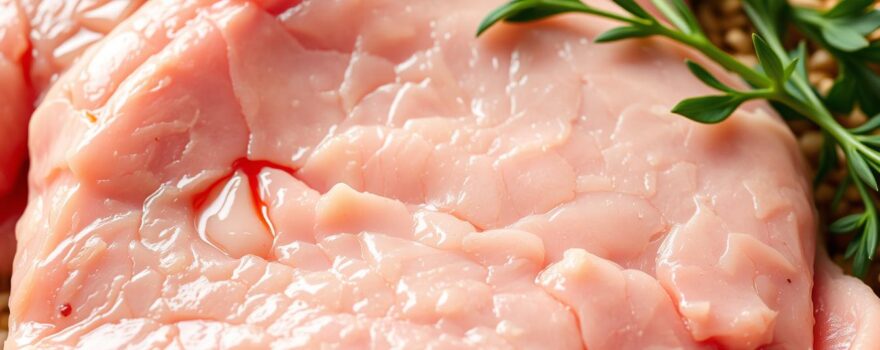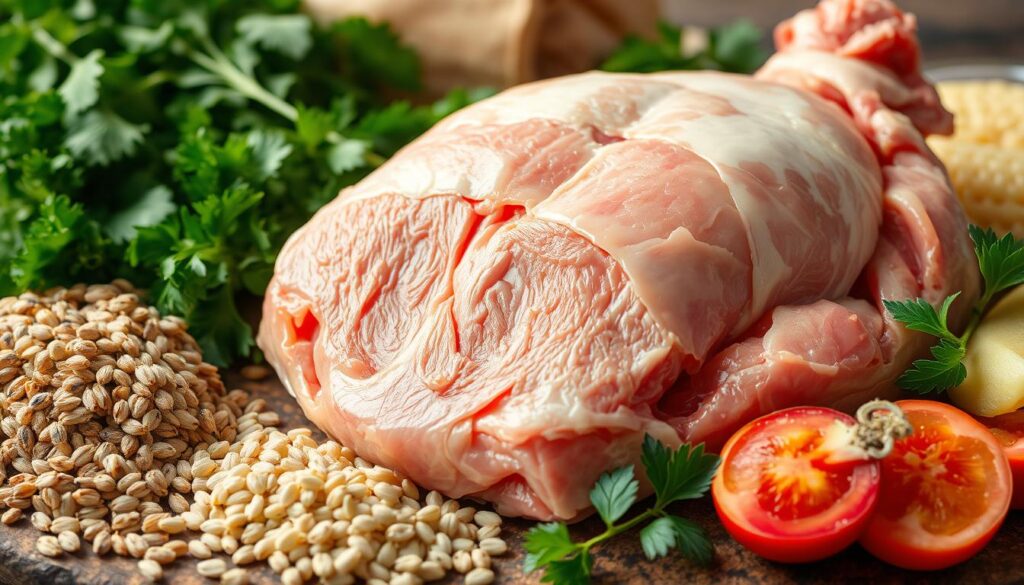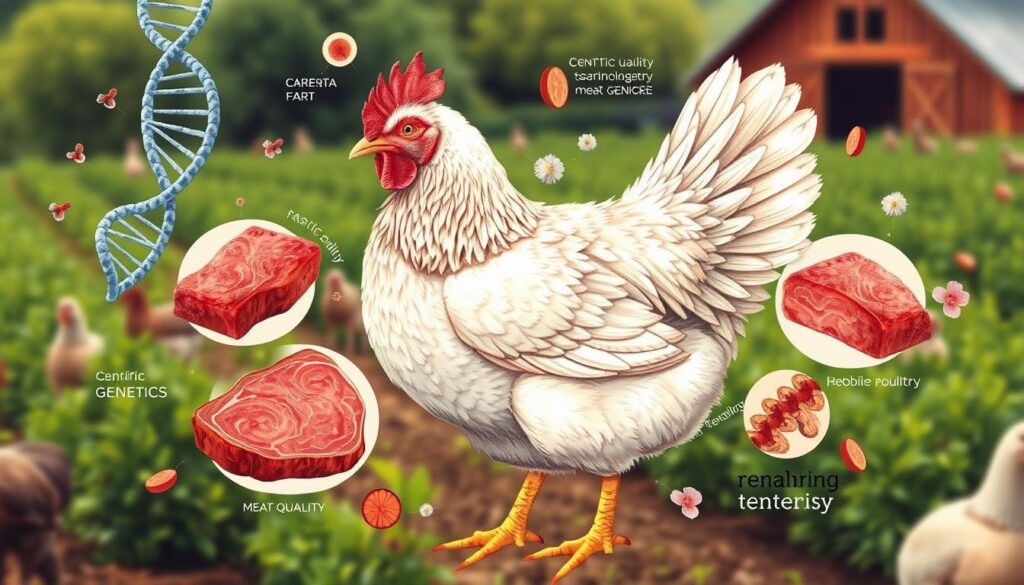
Broiler chicken meat is loved by many around the world. It’s affordable, tastes great, and is good for you. The global poultry industry is booming, with plans to produce over 139 million metric tons in 2023. This growth focuses on making broiler meat better.
Meat quality matters a lot. Things like how it looks, feels, and tastes are key. They affect how happy customers are with their meat.
There are also important numbers that show how good the meat is. These include how much water it holds, how tender it is, and how long it lasts. The food the chickens eat affects the meat’s quality and safety. This is because what they eat changes the meat’s fat content.
Key Takeaways
- Broiler chicken meat is a popular choice among consumers due to its affordability, taste, and nutritional value.
- Meat quality attributes, such as appearance, texture, juiciness, and flavor, are crucial factors influencing consumer preferences.
- Quantifiable meat properties, including water-holding capacity, shear force, and pH, are essential for processors manufacturing value-added meat products.
- Broiler chicken nutrition has a significant impact on the quality and safety of the resulting poultry meat, as the dietary fatty acid profiles are reflected in the tissue fatty acid composition.
- The global poultry industry is expected to see continued growth, with production exceeding 139 million metric tons in 2023.
Introduction to Broiler Chicken Meat Quality
Quality in broiler chicken meat is complex. It means the characteristics that make each piece different and important to the buyer. These include physical, chemical, and sensory traits.
The key features that affect how people see and taste meat are its appearance, texture, juiciness, wateriness, firmness, tenderness, odor, and flavor. These meat quality attributes are vital in shaping what consumers think of meat quality.
By 1999, the world produced 40 billion chickens. This number is expected to grow by 2020. Chicken is popular because it’s leaner than red meat, making it good for health.
“Chicken muscle is a significant source of protein globally, with broiler meat quality being a crucial determinant of its palatability and sensory attributes.”
Recent studies have focused on chicken meat quality. Genetics play a big role in its traits, like color, texture, and protein content.
Importance of Nutrition in Poultry Meat Quality
Dietary Fatty Acid Profiles and Meat Quality
Poultry nutrition is key to the quality and safety of poultry meat. The fatty acids in feed directly affect the fatty acids in the bird’s tissues. This link between dietary fatty acid profiles and meat quality is vital for producers and processors.
The connection between feed composition and meat attributes is strong. Processors focus on meat properties like water holding capacity and pH. These ensure the final product is of high quality and profitable.
Research shows a strong bond between poultry nutrition and meat quality. Genetic differences in birds can affect meat quality. Selecting birds based on genetics can improve meat quality.
The fatty acid profile and meat quality relationship is critical in poultry production. It needs careful management to provide safe, nutritious, and high-quality meat to consumers.
How Diet Affects the Taste and Texture of Broiler Chicken Meat
The diet of a broiler chicken greatly influences the taste and texture of its meat. The type of fatty acids in their diet, especially unsaturated ones, can make a big difference. For example, adding prickly pear peel powder (PPP) to their food can improve the meat’s taste and texture.
Research shows that broilers eating 15% PPP have better taste, color, and smell. They also have more tender meat and are more appealing to eat. This diet also helps them grow faster and more efficiently.
| Dietary Factors | Impact on Meat Taste and Texture |
|---|---|
| Unsaturated Fatty Acids (e.g., PPP) |
|
| Maturity of Connective Tissues |
|
| Contractile State of Myofibrillar Proteins |
|
| Environmental Stress and Handling |
|
Other things like the age of the chicken and how it’s handled can also change the meat’s texture. Knowing these factors helps producers and processors make better chicken meat. This makes the meat more appealing to consumers.

Impact of Management Practices on Meat Quality
The quality of broiler chicken meat is not just about what they eat. It’s also about how they are managed and the environment they are in. From how they are handled before being slaughtered to the conditions of the slaughterhouse, many factors play a role. These can affect the taste, texture, and look of the meat.
Environmental Conditions and Handling
Stress and excitement before slaughter can change the color of turkey meat more than chicken. The color of the meat comes from myoglobin and muscle pH. Several things can affect the color, including how the chicken is handled before.
Chicken muscles with a pH of 6.0 or higher look more translucent. Those with a lower pH are more opaque due to protein changes.
| Factor | Impact on Meat Quality |
|---|---|
| Genetics | Genetics play a big role in meat quality, with heritability estimates between 0.35 and 0.81. Genetic differences can lead to big variations in meat quality. |
| Pre-slaughter Handling and Stress | Handling and stress before slaughter can greatly affect meat color, tenderness, and quality. |
| Processing Conditions | Things like stunning methods, nitrates, additives, pH, and cooking temperature can all impact meat quality. |
Keeping the environment right and handling chickens well before slaughter is key. It helps keep the management practices and broiler meat quality, environmental conditions and meat quality, and pre-slaughter handling and meat quality of broiler chicken meat high.
“Consumers in the UK tend to prefer white, non-pigmented skin in poultry meat, and broilers have lower heme pigment concentrations compared to turkeys.”
Role of Processing in Broiler Meat Quality
After a bird is killed, how its meat changes is key to its quality. The temperature of the carcass affects how the meat becomes tough or tender. This is due to changes in the meat’s chemistry and pH levels.
How we process broiler meat is also important. It affects the meat’s nutritional value. The way the meat changes from muscle to meat impacts its tenderness. This is because of a process called rigor mortis followed by softening.
| Processing Aspect | Impact on Broiler Meat Quality |
|---|---|
| Automation and Mechanization |
|
| Sorting and Grading |
|
| Color Management |
|
In summary, the way we process and handle meat after it’s killed is vital. It affects the meat’s tenderness, texture, color, and overall quality. Knowing these changes and techniques helps us make better meat that people want to eat.
Genetic Influences on Broiler Meat Quality
The quality of broiler chicken meat is influenced by more than just diet and management. Genetics also play a big role in its taste, texture, and overall quality. Different genes in birds can lead to big differences in meat quality.
Studies show that genetics have a huge impact on meat quality in broilers. Heritability estimates range from 0.35 to 0.81. This means genetics can be a powerful tool for better meat quality. Broilers have less heme pigment than turkeys, likely because they reach market age younger.
Many broiler breeds can’t deposit pigments in their skin. This makes their meat white, no matter their diet. This genetic trait is key for producers aiming to meet consumer color and appearance preferences.
| Trait | Heritability Range |
|---|---|
| Meat Tenderness | 0.35 – 0.81 |
| Meat Juiciness | 0.40 – 0.72 |
| Meat Flavor | 0.45 – 0.75 |
| Meat Color | 0.30 – 0.68 |
The high heritability of meat quality traits in broilers shows how important genetic factors and broiler meat quality are. By using selective breeding, producers can improve meat quality. This meets the changing tastes of today’s consumers.

“Genetics determine muscle structure, fat distribution, and growth rate of animals, impacting the taste and texture of meat.”
Emerging Trends in Broiler Meat Production
Alternative Feed Ingredients and Additives
The poultry industry is looking for new feed options as prices go up. Organic acids, like humic acids, are becoming popular. They help farmers make more money and give people healthier chicken.
In the European Union, finding new feed supplements is key. This is because antibiotics can’t be used to help chickens grow anymore.
Humic substances, made from old plants, help chickens grow stronger. They also boost the immune system. Some special kinds of humic substances even fight viruses. This makes them great for chicken food.
These new ways of feeding chickens are changing the game in poultry production. They’re all about alternative feed ingredients for broilers and feed additives and broiler meat quality.
| Ingredient | Benefit |
|---|---|
| Organic Acids (Humic Acids) | Improved profitability, healthier poultry products |
| Humic Substances (HS) | Increased weight gain, enhanced immune function, antiviral properties |
The poultry industry is always changing. Using alternative feed ingredients and innovative feed additives is key. It helps keep chicken meat good and meets the world’s growing demand for it.
Consumer Preferences and Meat Quality
As people become more aware of health and nutrition, they care more about broiler meat quality. They look at nutritional value, calorie content, and how it’s made. Poultry meat and eggs are popular because they’re nutritious and low in calories.
But, whether a poultry product meets consumer expectations depends on its life cycle. This includes everything from the egg to the final product. Looks, feel, and taste are key in what people want from their meat.
Appearance and Color
Appearance is crucial for poultry meat, with different colors preferred in different places. Genetics, diet, handling, and stress before slaughter affect meat color. Bruising can cause color changes, but it usually returns to normal.
Texture and Tenderness
Texture, especially tenderness, matters a lot to consumers. Tenderness comes from the meat’s structure and how it’s handled. The way muscle turns into meat also affects tenderness.
Flavor and Aroma
Flavor and aroma are also important for meat quality. The bird’s diet, genetics, and how it’s processed can change taste and smell. These factors influence what consumers like.
As the demand for poultry products grows, understanding what consumers want is key. Producers and processors need to keep up with these changes to stay competitive and meet health-conscious consumers’ needs.
Challenges and Future Directions
The poultry industry has to tackle many challenges to improve broiler meat quality. One big issue is the variation in muscle type. This leads to differences in color and appearance between dark and light meat. Color defects like mottling and extreme paleness also hurt the industry’s image.
Improving the taste, texture, and overall quality of broiler meat is key. Emerging trends, such as using alternative feed ingredients and additives, show promise in this area.
- Addressing challenges in improving broiler meat quality, including muscle type, color variation, and appearance defects.
- Shifting the emphasis from solely aesthetic attributes to improving the functional properties of broiler meat, ensuring a high-quality final product.
- Exploring the potential of emerging technologies, such as alternative feed ingredients and additives, to enhance broiler meat quality and address consumer preferences.
The poultry industry must evolve to meet these challenges. Focusing on emerging technologies for enhancing meat quality is essential. By adopting new methods and listening to what consumers want, the industry can offer better broiler meat. This will make both producers and consumers happy.
“Poultry meat production is projected to increase by 34% by 2018, emphasizing the need to address quality challenges and explore future research directions.”
Conclusion
Broiler meat quality comes from many factors. These include nutrition, management, processing, and genetics. Knowing how diet affects taste, texture, and overall experience is key. This knowledge helps improve broiler meat quality and meet consumer demands for healthy, high-quality poultry.
Genetic improvement is crucial, with heritability estimates showing its impact. Meat color, texture, and tenderness are also important. These are influenced by several factors, including sex, age, and processing methods.
The poultry industry must adapt to changing consumer preferences. It needs to focus on sustainable development and address challenges like breast muscle myopathies. By doing so, it can continue to offer consumers high-quality, nutritious broiler meat.